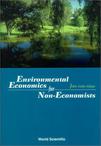非经济学家环境经济学须知ENVIRONMENTAL ECONOMICS FOR NON-ECONOMISTS
2000-1
World Scientific Publishing Company
John Asafu-Adjaye
321
无
With the rise in the significance of environmental issues, many professionals and students outside the discipline of economics have taken an interest in environmental economics. However, there are few publications that cater for this type of reader The invaluable textbook is targeted at a broad range of disciplines, including engineering, business, forest and agriculture. The following characteristics set the book apart from others: it does not assume a previous knowledge of economics; it deals with global environmental problems, with emphasis on Third World environmental issues; it includes material on the emerging discipline of ecological economics; and it incorporates simple spreadsheet-based examples and exercises to reinforce the concepts taught.
ForewordPreface1 Introduction 1.1 The Role of Environmental Economics 1.2 Defining the Natural Environment 1.3 Overview of This Book ReferencesPart Ⅰ.Introduction to Environmental Economics: Theoretical Foundations 2 Incorporating the Environment into the Economic System:Introduction to Ecological Economics 2.1 Introduction 2.2 What is Ecological Economics? 2.3 Economy-Environment Systems 2.4 Thermodynamics and the Environment 2.5 Modelling Economy-Environment Interactions 2.6 Summary Review Questions Exercises References 3 How Markets Work 3.1 Introduction 3.2 The Competitive Market 3.3 Consumer Behaviour and Demand 3.4 Producer Behaviour and Supply 3.5 Market Equilibrium in the Competitive Market 3.6 Consumer and Producer Surplus 3.7 Applications of the Competitive Model 3.8 Summary Review Questions Exercises Further Reading 4 Why Markets 'Fail' 4.1 Introduction 4.2 Types of Market Failure 4.3 Externalities 4.4 Type of Market Structure 4.5 Approaches to the Solution of Environmental Pollution Problems 4.6 Government Policies 4.7 Summary Review Questions Exercises ReferencesPart Ⅱ. Tools for Environmental Policy Analysis 5 Environmental Valuation 5.1 Introduction 5.2 Types of Economic Values 5.3 Non-Market Valuation Methods 5.4 Summary Review Questions Exercises References 6 Cost-Benefit Analysis 6.1 Introduction 6.2 Utility, Benefits and Costs 6.3 Defining Objectives and Project Scope 6.4 Identifying and Screening the Alternatives 6.5 Identifying the Benefits and Costs 6.6 Valuing the Costs and Benefits 6.7 Calculating Discounted Cash Flow and Project Performance Criteria 6.8 Concepts of Risk and Uncertainty …… 7 Cost-Effectiveness Analysis,Impact Analysis and Stakeholder Analysis 8 Multi-Criteria AnalysisPart Ⅲ. Global Environmental Issues 9 Population Growth,Resource Use and the Environment 10 Trade and the Environment 11 Sustainable Development 12 Assessment of Global Environmental Trends and Policy ImplicationsIndex

无
非经济学家环境经济学须知ENVIRONMENTAL ECONOMICS FOR NON-ECONOMISTS PDF格式下载